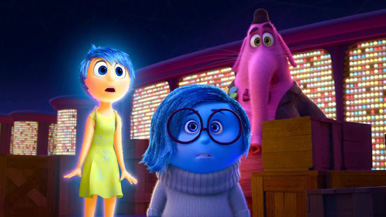Movie Review: Inside Out
By Matthew Huntley
June 25, 2015
The underlying premise behind Inside Out is so familiar and filled with so many creative possibilities that it’s somewhat baffling to think it took any filmmaker this long to realize it, particularly as an animation, which tends to offer more visual freedom than real-life actors and sets. The idea that little people live inside our heads and control how we feel seems long overdue. Then again, maybe the amount of time it took Inside Out to reach theaters is a good thing, because it’s clearly been done right. It will no doubt become Disney-Pixar’s latest crowd pleaser.
Of course, how our minds function and what drives us to make certain decisions isn’t exactly a novel subject for the movies. For instance, how many times have we seen a character’s conscience split into two, with a white angel sitting on one shoulder and a red devil on the other? There was also Being John Malkovich and The Cell, both of which explored, albeit very differently, the concept of outside individuals acting as a proxy in someone else’s head and therefore influencing how they behaved.
But Inside Out takes a fresh approach and suggests emotions themselves are distinct individuals, each with their own unique personality, who are responsible for how we feel at any given moment. They occupy our mind’s central hub, called Headquarters, and the emotion we project to the outside world is based on the last one to press the hub’s main release button. Leading the pack is the wide-eyed and ceaselessly positive Joy (voice of Amy Poehler), who narrates the story. She’s joined by the blue and bespectacled Sadness (Phyllis Smith); the purple and skinny Fear (Bill Hader); the green and sarcastic Disgust (Mindy Kaling); and the red, fiery Anger (Lewis Black).
The movie informs us that all people (and animals) have such a group living inside their minds, but the story focuses on 11-year-old Riley (Kaitlyn Dias). Joy and the others have been with Riley ever since she opened her eyes and together they create tiny spheres of memories. The “core memories,” comprised of Riley’s most important life experiences, make up the five islands of her personality, which vary from person to person, but in Riley’s case, these include Family, Friendship, Hockey, Honesty and Goofball, or at least that’s what they are now.
For all of Riley’s life, the five emotions have maintained a relative status quo and mostly happy times, but things suddenly change when Riley’s mom (Diane Lane) and Dad (Kyle MacLachlan) decide to move from Minnesota to San Francisco, sending the team through their own emotional whirlwind. Should the new move make Riley happy, sad, scared, or angry? It’s not exactly clear and that puts everybody on edge. Plus, poor, remorseful Sadness, feeling left out because she doesn’t quite know her purpose yet, can’t help but touch Riley’s latest core memory and turn it into a sad one. She also feels compelled to touch previous happy memories and make them sorrowful.
Continued:
1
2
|
|
|
|




